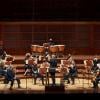
One magical piece of the concert experience is that you never know what will happen, not from a distance, not when entering the hall.
The long-range expectation in the middle of the pandemic could not have forecasted the triumphant final concert on June 25 by the San Francisco Symphony at the end of an abbreviated, much-challenged sort-of-spring-season in May and June — after a 15-month hiatus and before a nearly normal summer season. Nor could those entering the packed auditorium under changed health regulations imagine how the splendid performances would sweep away their concerns on the wings of music.
Some initial worries were justified, sitting elbow-to-elbow with strangers in a full hall, at an event no longer requiring proof of vaccination or a recent COVID-19 test. SF Symphony just eliminated those measures for the last two concerts before the beginning of the summer season, keeping only the mask requirement.

Esa-Pekka Salonen’s ideas changed for these two concerts, with the music director crafting a varied, masterfully performed program by an orchestra on fire, but without Salonen’s trademark emphasis on contemporary music.
The timeline ranged from Giovanni Gabrieli at the end of the 16th century, to Robert Schumann’s 1850 Symphony No. 3, to Richard Strauss’s 1944 Metamorphosen. The subtle, brooding Strauss was placed between the big-brass sound of the Gabrieli and the surge of Schumann’s “Rhenish” Symphony.
Facing each other from the side terraces over the stage, brass players performed principal trombonist Timothy Higgins’s fabulous arrangements for various groupings and double brass choir. In three works from Gabrieli’s Sacrae symphoniae, Davies Hall resonated to the gloriously secure sound of the orchestra’s splendid brass players, evoking the surround-sound of great cathedrals, enchanting the audience with the Venetian composer’s antiphonal music.
Despite his self-effacing manner and brief tenure with the SF Symphony to date, Salonen’s star status in the city matches the popularity of those who have spent decades here. He was greeted with thunderous applause that forced him, after his usual quick bow and turn to face to the orchestra, to stop and take another bow, hand on his heart.
By the time the Schumann came around, Salonen stopped the applause that greeted him with a sudden turn and a mighty downbeat to tear into the first movement, which is marked lebhaft (lively), making it riotous, and continuing to emphasize forte dynamics through the movement and also in the final movement, also marked (and performed) lebhaft.
Between the two more-than-lively movements came those marked “very moderate,” “not fast,” and “solemn” (invoking the Rhine and the Cologne Cathedral) — each interpreted just right, without the extra amplification of the bracketing “lively” ones. Throughout the concert, the audience, ushers, and all string players were masked, but not the winds, brass, or the conductor.
Seeing the full orchestra on stage and hearing all sections perform at their best was exhilarating, and yet, at least to this listener, the heart of the concert was at the midpoint.

Strauss wrote Metamorphosen in April 1945, in the closing days of World War II, as Hitler died in his bunker and Allied forces turned much of Germany into rubble. Strauss was 80, in poor health, and complaining about a lack of inspiration to compose. When the Nazi government forbade his travel to a Swiss sanatorium, Karl Böhm suggested writing a work for strings that would be premiered in Zürich.
Metamorphosen is different from all other works by Strauss, with few generically similar in chamber music either; Schoenberg’s Verklärte Nacht (Transfigured night) comes close, with one crucial difference: It has a heartbreaking catharsis, which cannot be found in the Strauss.
Metamorphosen’s pensive sound, without resolution, may well be Strauss’s expression of mourning for the devastating war, the destruction in the days before its composition of such intimate homes to his works as the Munich and Vienna opera houses.
Written for 23 “solo strings” (rather than a string ensemble), the work did have 23 brilliant soloists on Friday among the SF Symphony musicians, with Concertmaster Alexander Barantschik and Associate Principal Cellist Peter Wyrick being first among equals.

Leading the mesmerizing performance, Salonen combined Georg Solti’s physicality with Karl Böhm’s subtle, total mastery, and if anything, he surpassed his previously acclaimed conducting of the work, such as a recent one in Hamburg.
Good news for those who missed these concerts (and those who want to experience it again): The performances were filmed and recorded for future release on SFSymphony+. (The Thursday performance will have to be used to patch the electronic buzz in the fourth minute on Friday.)
The constant movement of spooky, black-clad sentinels upstage carrying cameras was a bit distracting, but that was a small price to pay for having the performance recorded.



